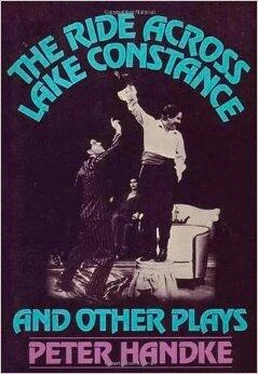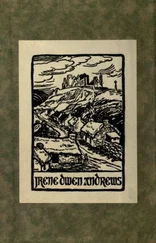For some time, that is, at least until the audience begins to pay attention, the characters move quietly around the stage like this, with their belt buckles, their collar patches, brooches and rings glinting in the muted light. Then while the chatter gradually subsides, because more and more characters stop talking, one can still hear one of them say: “What, when the pain becomes unbearable you want to simply waste them like animals?” And another replies: “Yes, should animals be any worse off than human beings?” And a little later someone else: “Yes, if I’d defended him at the trial, he might even have been able to wriggle his way out.” And after the chatter has even further subsided — only now does one notice how heavily made up the characters are — the lady with the fan says softly but distinctly: “Even before he touched me I began to cream.” And the two bodyguards, who stand quite far away, exchange obscene gestures. One pushes his thumb out between the middle and index finger of a closed fist; the other immediately replies by making a fist and whopping quickly up and down on the other fist. From the lady with the lapdog one hears, already as a memory, a pretty, long-drawn-out “Ahh …” and at this point it becomes gradually dark on stage and the curtain drops.
Translated by Michael Roloff
The Ride Across Lake Constance
It’s a winter night. A man rides across Lake Constance without sparing his horse. When he arrives on the other side, his friends congratulate him profusely, saying: “What a surprise! How did you ever make it! The ice is no more than an inch thick!” The rider hesitates briefly, then drops off his horse. He is instantly dead.
M.R.
Characters
WOMAN WITH WHITE SCARF
EMIL JANNINGS
HEINRICH GEORGE
ELISABETH BERGNER
ERICH VON STROHEIM
HENNY PORTEN
ALICE AND ELLEN KESSLER
A DOLL
To avoid character designations such as “Actor A,” “Actor B,” “Actress C,” and so on, for reading and other purposes the characters in the play have been given the names of well-known actors.
When the play is staged, the characters should bear the names of the actors playing the roles: the actors are and play themselves at one and the same time.
“Are You Dreaming or Are You Speaking?”
The stage is large. It displays a section of an even larger room. The background is formed by the back wall of this room; the wall is covered by a brownish-green tapestry with a barely perceptibly pattern. Along the back wall two parts of a staircase lead down from the right and left and meet in the center of the wall, where they form a single set of wide stairs, of which a number of steps lead forward into the room. The audience therefore sees persons walking down the stairs first in profile, then from the front. In the wall beneath the right and left parts of the stairway are two barely visible tapestry doors. The staircase has a delicately curved, slender bannister. The floor of the room is covered with an unobtrusive carpet whose color matches the tapestry; a wine-red runner leads down the staircase steps.
Most of the furnishings in the room are covered with dropcloths; these are extremely white. In the center of the room, not precisely center of course, rather almost downstage, stands a large dark table, partially covered by a lace tablecloth; on it are an ashtray, a cigar box, a teapot or coffee pot covered with an embroidered cozy, a longish cutlery case, also of embroidered cloth, and two candlesticks sheathed in protective covers. To the right and left and behind the table stand three fauteuils with white dropcloths; next to and behind them are an easy chair and a straight chair, dropcloths over both. In front of one of the fauteuils stands a stool upholstered the same and the same height as the fauteuil that may serve as a footrest; a smaller footstool stands in front of the second fauteuil; the third fauteuil stands by itself. To the right of the table, a few steps away, stands a small bar, not covered, with several bottles whose forms indicate their respective contents. To the left of the table, a few steps away, stands a newspaper table, not covered either, with a few bulky magazines, some of which are still rolled up; on top is a record player with a record on it. Looking further to the left and right behind the newspaper table and bar one sees two sofas, also concealed by white dropcloths. To the left side of the left sofa is a brown-stained chest, with several drawers; on it a small statue covered with a white paper bag. On the right side of the right sofa leans a guitar in a bag embroidered like the tea cozy. Beneath the sections of the staircase hang two pictures on the wall concealed behind white sheets. Downstage to the extreme right, in line with the table, is a Japanese screen of the kind one usually sets up in front of beds. It is small and has three panels; two of them are slightly pushed together, the third is open and visible to the audience. The screen has the same pattern and color as the back wall.
All objects are in such a position that it would be difficult to imagine them standing elsewhere; it is as though they could not bear being moved ever so slightly. Everything appears as though rooted to the spot, not only the objects themselves but also the distances and empty spaces between them.
The light is that of early morning.
After the curtain has opened, two portieres to the right and left of the proscenium are revealed, as portieres to a chambre séparée.
A WOMAN, her hair wrapped in a WHITE SCARF , moves quickly but not hastily among the objects with a vacuum cleaner. She is in blackface. The vacuum cleaner, which was turned on the moment the curtain began to open, makes a more or less steady noise.
On a fauteuil beside the table, his legs on the appropriate footstool, sits EMIL JANNINGS, his eyes closed. He is quite fat. His boots stand next to the stool. He is wearing red silk socks, black pants, a light-colored shirt, open at the collar. He seems costumed although only hints of a costume are visible: rather long frills on the sleeves of the silk shirt, a wine-red silk sash around his stomach.
He is heavily made up, the eyebrows are painted. On the right hand, whose nails are lacquered black, he wears several large rings.
He has not moved since the curtain opened, and the WOMAN has nearly completed her work. Pushing the vacuum cleaner back and forth near the newspaper table with one hand, she turns on the record player with the other.
However, one hears only a few isolated sounds; the vacuum cleaner is too noisy.
She takes the cleaner to the back wall and turns it off so that the music becomes audible: “The Garden Is Open” by T. Kupferberg. She pulls the plug out of the socket, rolls it up on the machine, and places the machine behind the tapestry door.
While the record continues to play, she walks from object to object and takes off the dropcloths, except those on the paintings and on the statue. Although she moves fairly slowly, her work is proceeding quite rapidly; at least, one barely notices it. She pulls the cover from under EMIL JANNINGS with a single movement and walks off to the left while the record is still playing.
Then nothing moves onstage for a while except for the record.
The record player turns itself off, and after a moment JANNINGS slowly opens his eyes.
JANNINGS
( With a cracked voice ) As I said — (He clears his throat once and repeats in a firm voice .) As I said. ( Pause. ) A bad moment. ( Someone behind the screen with a cracked voice: “Why?” He clears his throat twice; the second time he does so he steps out from behind the screen, repeats then in a firm voice : “Why?” It is HEINRICH GEORGE, quite fat, his clothes also suggesting a costume, with braids trimming his jacket and with lace-up shoes. He stands there . JANNINGS has turned his head away slightly .) It’s over already.
Читать дальше











